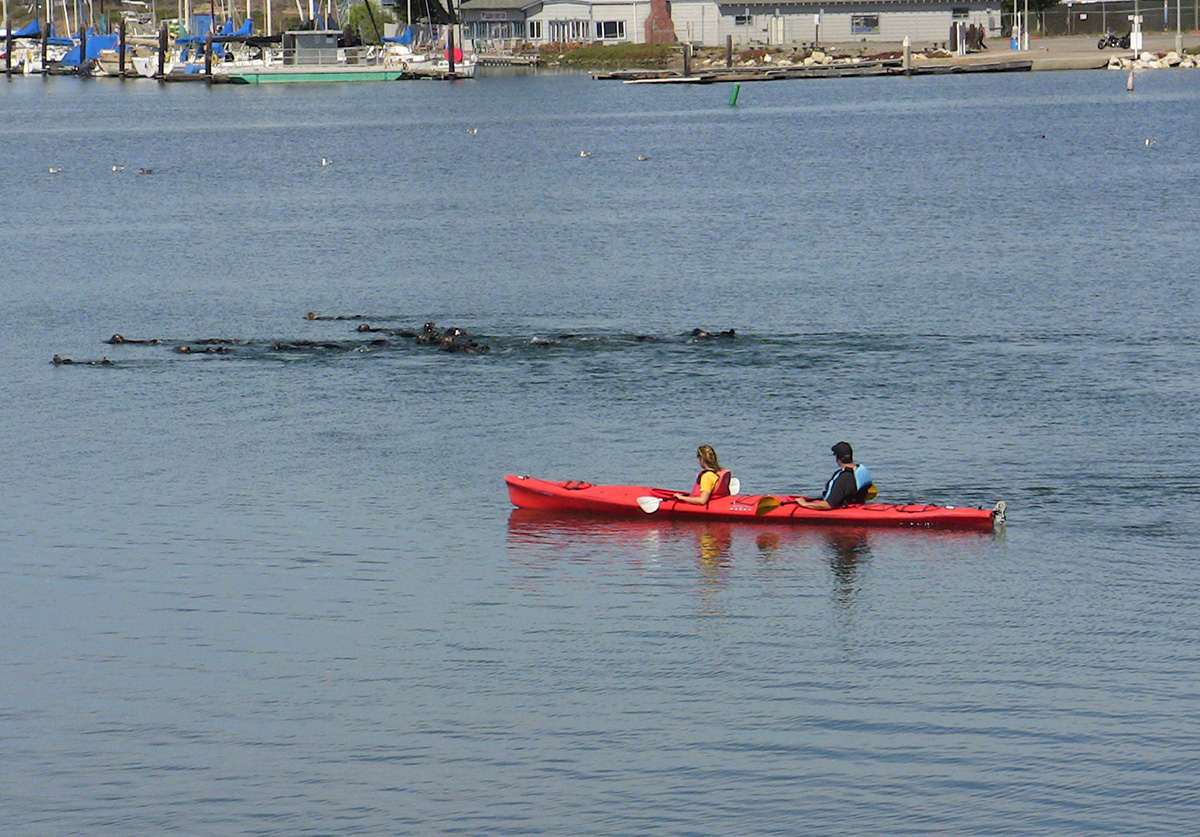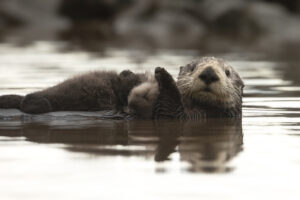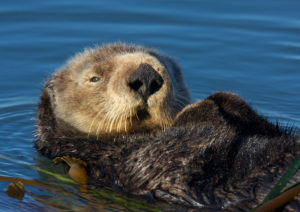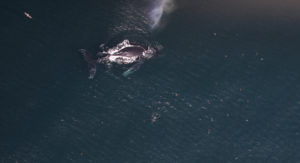For the sea otters of Moss Landing, the beginning of summer is a stressful time. In a normal year, when the weather warms, tourists flood onto Elkhorn Slough, a meandering seven-mile-long estuary, to kayak alongside California’s iconic marine mammal — and maybe snap a few pictures for social media.
The otters, which normally spend over a third of their day resting and napping, can’t catch a break.
“In the summer, there’s an armada of kayakers,” said Brent Hughes, an ecologist at Sonoma State University, “They’re in defense mode for a portion of every morning.”
Since the Monterey Bay Aquarium began introducing rehabilitated sea otters into Elkhorn Slough two decades ago, the charismatic creatures have fueled a growing ecotourism industry. Sea otters, once driven to the brink of extinction by the fur trade, are now beloved. But their popularity might be harming them. Research suggests that the constant presence of humans stresses the otters’ health, adding to their difficulty finding enough calories to stay warm and making it harder to fight off disease.
For a creature that spends most of its time in cold water, sea otters have surprisingly little padding. Unlike other marine mammals, they have no blubber. Although they eat 25 percentof their body weight in crabs and other shellfish, otters burn so many calories trying to warm themselves up that they continuously hover on the brink of starvation.
“They’re really just meeting that basic energetic need on a daily basis,” said Gena Bentall, the director of Sea Otter Savvy, an organization dedicated to educating the public on interacting with wildlife. “It’s like living paycheck to paycheck every day.”
Sea otters nap to save energy. A kayaker approaching, armed with a smartphone, wakes them up. Occasionally getting spooked probably wouldn’t be such a bad thing for the otters, Bentall said, “but it’s chronic.” Sea otters get startled by humans six times per day, on average, according to Bentall. The calories they burn repeatedly escaping curious tourists could have consequences.
[T]he scientists calculated that to replenish the calories burned by getting startled six times per day, otters need to eat an extra third of a crab each day, or 11 clams.
For her graduate thesis at Moss Landing Marine Laboratories, Heather Barrett worked with a team of scientists to analyze the relationship between potential sources of danger, such as boats and humans, and otter activity. Barrett studied three years worth of data collected by citizen scientists and researchers at Sea Otter Savvy. Several times each week, the scientists had gone out and observed the otters for hours at a time, jotting down, at regular time intervals, what each otter was doing and their proximity to potential sources of danger. Based on this data, Barrett found a 50 percent likelihood that an individual otter scatters when boats and humans approach within 30 feet, and 15 percent it will try to escape when a potential danger source moves within 100 feet. Based on those findings, the scientists calculated that to replenish the calories burned by getting startled six times per day, otters need to eat an extra third of a crab each day, or 11 clams.
That doesn’t sound like much, but it’s enough to add up over time, said Barrett, who is now a research scientist at Sea Otter Savvy. The scientists’ calculations were conservative — they only measured the likelihood of otters swimming away when frightened, so their estimates don’t take into account the energy it takes for otters to keep vigilant watch over boats farther in the distance. Plus, foraging for that extra food means even less time spent napping, and more energy lost.
Historically, around 16,000 sea otters lived along all of California’s coastline and islands. They were hunted to what people thought was extinction by the early 1900s, but a small population survived on the remote Big Sur coast. From those few dozen otters the population has grown steadily on the Central California coast to around 3,000. The recovering otter population peaked in 2016 at more than 3,270, but has declined since to 2,962 in 2019.
“The recovery status has flatlined,” Hughes said. Researchers say the two primary causes of the death for otters are shark bites and parasite infections. Starvation is a close third, according to a 2019 study of otter autopsies led by scientists from the U.S. Geological Survey.
Female otters with pups are hit the hardest by starvation. Because they need to produce milk and watch their babies, mothers have especially demanding metabolisms. Autopsies of 108 dead female sea otters revealed that 56 percent had died of end lactation syndrome, a state of exhaustion and emaciation that can afflict sea otter mothers as they wean their pups.

Today, otter populations in central California are about as dense as they were before the fur trade nearly wiped them out, said Tim Tinker, a sea otter ecologist at the University of California Santa Cruz. To some extent, starvation is a natural consequence of healthy population growth. With more sea otters, there’s less food to go around.
Still, experts see disturbance as an obstacle to recovery. In order to fully rebound, the otters will need to expand their populations farther north and south. On either end of their current range, otters face sharks and disease. By causing otters, especially mother otters, to waste energy, human disturbance compromises the ability of individual otters to recover from shark bites and parasitic infections, Tinker said.
“Within the current range, our goal is to limit this human-caused mortality as much as possible — that’s a requirement for any protected species,” Tinker said. “We want to focus on those things that we can affect.”
The otter’s current range isn’t just bounded by sharks and disease. It’s also bounded by major metropolitan areas. “If they move north, they’re going to move into San Francisco Bay; if they move south they’re going to move into L.A.” Hughes said. “They’re going to encounter a whole bunch of humans.”
Conservationists are already talking about reintroducing otters to the San Francisco Bay. Over the years, adventurous male otters have been spotted exploring the area, as well as nearby Tomales Bay. A recent study found that the San Francisco Bay could support 6,000 otters — if disturbance doesn’t get in the way.
Bentall and Barrett and the rest of the team at Sea Otter Savvy are trying to teach visitors to keep their distance. Their slogan: “Respect the nap.” Based on Barrett’s research, they recommend staying a full five boat-lengths from the otters.
“It’s been pretty challenging,” Bentall said.
This spring, though, has changed things for people and otters. In Moss Landing and Morro Bay, the shops that normally offer kayak rentals and boat tours have had to close down. “In the absence of the rental kayaks and SUPs [stand-up paddle boards] on the water, sea otters are undoubtedly experiencing fewer human interactions,” Bentall said in an email.
But shelter-in-place orders also mean research has come to a halt, and the scientists are unable to monitor the waters for privately owned boats. Sea Otter Savvy has had to move all education events online in the hopes that their pre-pandemic efforts to inform the public won’t be forgotten when people flood back into the parks, Bentall said.
The researchers hope that the pandemic will allow them to test the effects of ecotourism on the otters. Before COVID-19, Sea Otter Savvy along with their team of citizen scientists had collected data describing the health and activity of the otters. The scientists anticipate being back in the field before tourists return in numbers, so they should be able to collect a similar set of data describing otters in a lockdown world, with considerably fewer humans out on boats. “We should be well-positioned to do a comparative ‘before and after’ study,” Bentall said.
Ultimately, these dual efforts to understand the effects of ecotourism and to teach the public how to enjoy nature without harming it isn’t just about otters, Bentall said. “It’s about wildlife in general,” she said, “and how we relate to wildlife in a world that’s becoming ever more populated with people.”





